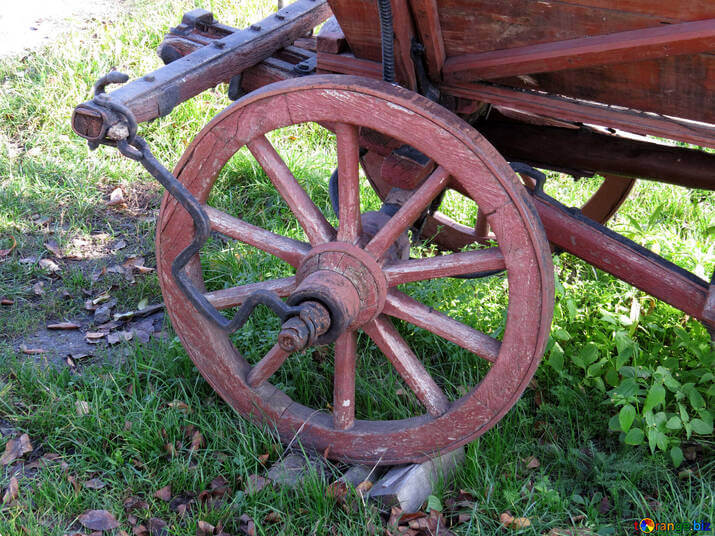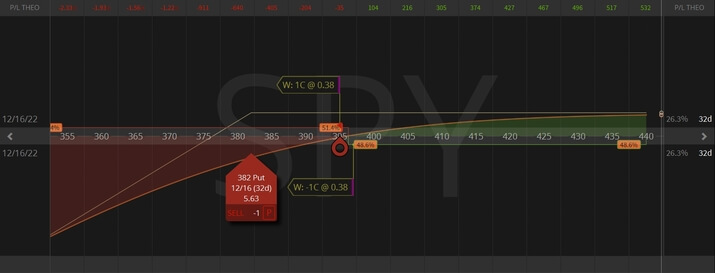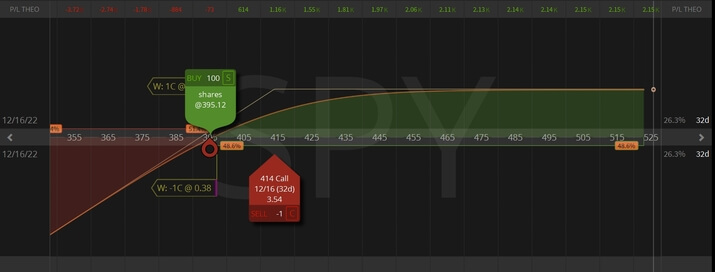The Wheel Strategy – Trading Options for Income
Are you looking for a new investment strategy that could potentially earn you consistent income? Look no further than the options wheel strategy. This options strategy involves two different options strategies into one for steady and reliable income potential.
Table of Contents
ToggleThe Options Wheel Strategy consists of cash-secured puts and covered calls. Two easy-to-understand strategies that can be used as an income strategy (collecting option premium), while also offering the investor the chance to buy and sell a stock at the price they want!
What is the Option Wheel Strategy?

The options wheel strategy is a great way to generate consistent income and potentially acquire stock at a discounted price. The first step is to sell a cash-secured put, meaning you have enough cash to purchase the underlying stock if it goes below the strike price.
If the position is assigned, you now own 100 shares and can use a covered call to continue earning additional premium. And once those shares get called away, just rinse and repeat by selling another cash-secured put.
Keep turning that wheel and collecting that sweet premium money. Just remember to always make sure you have enough cash on hand in case your positions get assigned.

A cash-secured put is an options strategy where you sell a put at a predetermined strike price at which you would like to purchase shares of stock. To “cash secure” the put, you must have enough cash in your account to cover the purchase price of the shares if the option is exercised.
The advantage of this strategy is that you can receive income from selling the put while waiting for the share price to drop to your strike price so that you can buy them at a discount.
However, you are also exposed to the risk of the share price dropping below your strike price and being forced to buy the shares at a higher price than they are currently worth.

A covered call is an options strategy involving the sale of call options on an asset you already own. The goal of a covered call is to generate income through the premium collected by the option seller, while still providing some upside potential should the price of the underlying asset increase.
If the price of the underlying asset remains unchanged or declines, the options expire worthless and you will keep all the premium as profit. Covered calls are typically sold out of the money, as this provides more upside potential in case the asset price increases.
The additional premium also lowers your cost basis and provides some downside protection by lowering your break even on your shares. The closer you sell the call to ATM the more downside protection it provides with the trade-off of less upside potential.
You will continue to sell covered calls until the call is exercised or they expire in the money (ITM), in which case you would be obligated to sell your shares at the strike price.
What Delta should I choose when making this trade?

When it comes to options trading, the term “delta“ is used to describe the rate of change in the price of an option for every $1 increase in the price of the underlying. In other words, delta is a measure of how sensitive the option price is to movements in the underlying price.
Delta can be either positive or negative, and it is typically expressed as a decimal number between 0 and 1. For example, if an option has a delta of 0.50, then it will gain or lose $0.50 in value for every $1 move in the underlying price.
Delta is an important concept for options traders to understand, as it can help them to manage their risk and make more informed trading decisions.
Which Delta Should I choose when selling cash-secured puts?
When it comes to selling cash-secured puts, I prefer to use around the .30 delta. This is far enough out of the money to provide a high probability of expiring worthless, as well as providing enough credit to make a decent return.
I sell cash-secured puts when I believe that the market will be relatively flat or move higher over the next month. By selling a put that is a .30 delta, I am implicitly saying that I believe there is about a 70% chance that the stock will be above the strike price at expiration.
If the stock does indeed rally, I pocket the premium and wait for another opportunity. If the stock falls and I am assigned, then I simply own the stock at a predetermined price and can start to sell calls against it immediately.
Which Delta Should I choose when selling a covered call?
When you start selling covered calls, choosing a strike price depends on how bullish you are. If you think the market is going to rally and don’t want to miss the stock appreciation, then somewhere around .20 delta is my usual choice.
If I was recently assigned shares and believe there is more downside to come, I will sell the call at the price I was assigned, attempting to bring in as much premium as I can.
This also gets the stock called away from you faster and allows for a quicker turnaround on the wheel. So, depending on your outlook and goals, sell a covered call to either collect option premium while allowing for an upside move or collect premium and get the shares called from you as quickly as possible.
What percentage of my buying power should I use?

Capital Intensive
The wheel options strategy is a capital-intensive way to trade, and in a perfect world, you would use 2-5% of your total capital on any one position.
ETFs have more stable pricing
A good place to start is with an ETF like SPY that has more stable pricing. Keep in mind, though, that you will need a large amount of capital for this. A single cash-secured put would use approximately $40,000 in buying power.
Much of your decision will come down to how much total capital you have. Just be careful not to invest too much in one trade.
Pros of the Option Wheel Strategy

The options wheel strategy is a popular income investing strategy that has several advantages.
Simplicity
There are many reasons to try the options wheel strategy, but its simplicity is certainly the number one reason. If you have always been interested in trading options, the wheel strategy is the perfect place to start.
Most people learn by doing, so don’t be afraid to get started and see how it goes. Pick a high-quality stock that you wouldn’t mind owning and start wheeling.
Income Producing
If you are looking for a strategy that will produce income, while also providing some protection to your capital then the wheel strategy may work for you. While you can’t avoid black swan events, the wheel essentially guarantees that you buy low and sell high.
Makes money in most market conditions
The wheel strategy is a popular investment technique that can help you to achieve good returns in most market conditions. You could potentially lose less money, compared to buy-and-hold investing, when the market has a pullback.
This is because you will have sold an out-of-the-money put option, or covered call, to give yourself additional downside protection. However, even the wheel won’t help you much when it comes to an extended bear market.
However, in a sideways-moving market, or one that experiences regular pullbacks, the wheel can help you to outperform the market. Overall, then, the wheel strategy can be a useful tool for investors – but it is important to be aware of its limitations.
Cons of the Option Wheel Strategy
Though the Wheel is great for beginners and has many benefits. It doesn’t mean this strategy doesn’t come with some cons. Let’s look at a few things you should know before you start selling options.
Very high capital requirement
The wheel strategy is a great way to make money in the stock market, but it does have one major downside: the capital requirement is much higher than most option strategies.
By selling cash-secured puts and covered calls you will need to have more money in your account to cover those trades. And if the market goes against you, you could quickly find yourself in a hole.
But if you’re careful and disciplined, the wheel strategy can be a great way to generate income and grow your account. Just be sure that you have the capital to back it up.
Low ROI compared to other option's strategy
When it comes to options trading, there are a variety of strategies that can be used to generate profits. Some of these strategies are riskier than others, but all of them have the potential to generate a decent return on investment (ROI).
The wheel strategy is not a strategy where you are going to double your account overnight. With this strategy, you can expect to generate an ROI of 1-3% per month. While this may seem low in comparison to other options strategies, it is important to remember that the wheel also comes with less risk.
The Wheel Strategy is boring
Many people who love watching the stock market find the wheel strategy to be a big problem. The strategy is slow and boring, and you could be in the same trade for months without seeing much profit.
If you prefer a strategy that requires frequent adjustments, then the wheel strategy isn’t for you. But, if you’re patient and don’t mind a little bit of boredom, then the wheel may be worth considering.
When is the best time to use the Option Wheel Strategy
High implied volatility
Any experienced investor knows that timing is everything. When it comes to selling covered calls and cash-secured puts, the best time to do so is during periods of high implied volatility. This is when options tend to be overpriced, and you can sell your options for a higher price than usual.
Of course, selling during times of high volatility also carries some risks. But for investors who are willing to take on a little extra risk, selling during periods of high volatility can be a great way to maximize profits.
Crab Markets
If you’re like most people, the phrase “crab market” probably doesn’t mean much to you. But if you’re a trader, it’s a term that you need to be familiar with.
A crab market is when a stock price can’t decide if they want to go up or down. They bounce around but tend to just stay around the same prices.
This is a great time to sell a cash-secured put or covered call, collect option premium, and let theta or time decay make you money. A crab market is when the wheel strategy will very likely outperform most other trading strategies.
Conclusion
The wheel strategy can be a great way for beginners to get started in options trading. It has many benefits, including a low capital requirement and the potential to generate an ROI of 1-3% per month.
However, there are some cons to consider before starting with this strategy, such as the high risk if the market goes against you and the relatively low ROI compared to other options strategies. With careful planning and discipline, however, the wheel strategy can be a great way for beginners to get comfortable with options trading and start generating profits.
FAQs about the Option Wheel Strategy

Is the wheel strategy bullish or bearish?
The options wheel strategy is a bullish strategy by nature but does well in bullish and flat market conditions. The wheel is made up of selling cash-secured puts and covered calls which are both bullish strategies.
Can you lose money from the wheel strategy?
The options wheel strategy is great for a market that crabs along, or slowly grinds higher. It doesn’t do well at all in a bear market, though you could lose less money, by selling covered calls, with the wheel strategy compared to stock ownership alone.








4 Comments